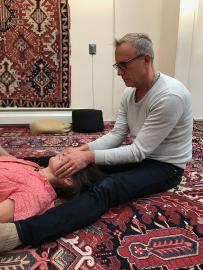
Mindfulness, meditation, and being present are popular topics. Decreased stress and tension, increased energy, clearer thinking, more connection, authentic relationships, better health, sharper memory, lower blood pressure, and less anxiety are all part of the appeal. But to experience these positive effects in our life, a commitment is necessary to start and then sustain a practice of being present.
Breema offers a three-fold approach that supports us to enter the present moment. Breema leaves nothing out. There are Nine Principles of Harmony to work with the mind, bodywork and self-care exercises to work with the body, and an essential teaching of nonjudgment to work with the feelings.
The self-care exercises deepen the connection to one’s own body. The partner bodywork releases tension both when receiving and when giving. The principles remind the practitioner of what is most important in any moment. The spoken exchanges that take place in classes express the essential relationship students have with themselves. The nonjudgmental atmosphere allows for mutual support and connection to body, mind, and feelings. Breema provides a solid foundation for an experience of being present in many ways.
In his recent book, Real Health Means Harmony with Existence, Breema Center director Jon Schreiber describes the accessibility and the purpose of the Breema practice:
“Breema is a way of life. It’s not just for when you are doing a treatment. It’s for your daily life. When you wake up in the morning, you could take a big breath, and say “thank you.” When you brush your teeth, you could be with the movement of your hand, with your posture. Why not experience the water on your face as you wash up? You could take a few seconds from each hour at your job to feel your body’s weight on your chair and say to yourself, “I want to know I have a body.” Then breathe. Each hour, why not choose one thing that you’re going to do anyway, and try to make that activity Self-Breema? When you’re going to open your bag and take out an apple, open the zipper with your whole body. Experience the movement of your arm as you bring the apple to your mouth. Let every cell in your body participate as you chew. These, or any other simple ways of bringing Breema into your day, can gradually change your life. Nothing can really help us unless we put it into practice. This is the first principle of development. Only doing can help.”
Although some practices emphasize attainment, being present is not something one can just achieve and retain. There is no diploma a person can receive that enables them to be present all the time. Presence is the experience of unity between body, mind, and feelings—that is the taste, the experience that Breema offers.
*The Practice of Being Present was written by Luna Lacey and originally published in Natural Awakenings Magazine of Boston.